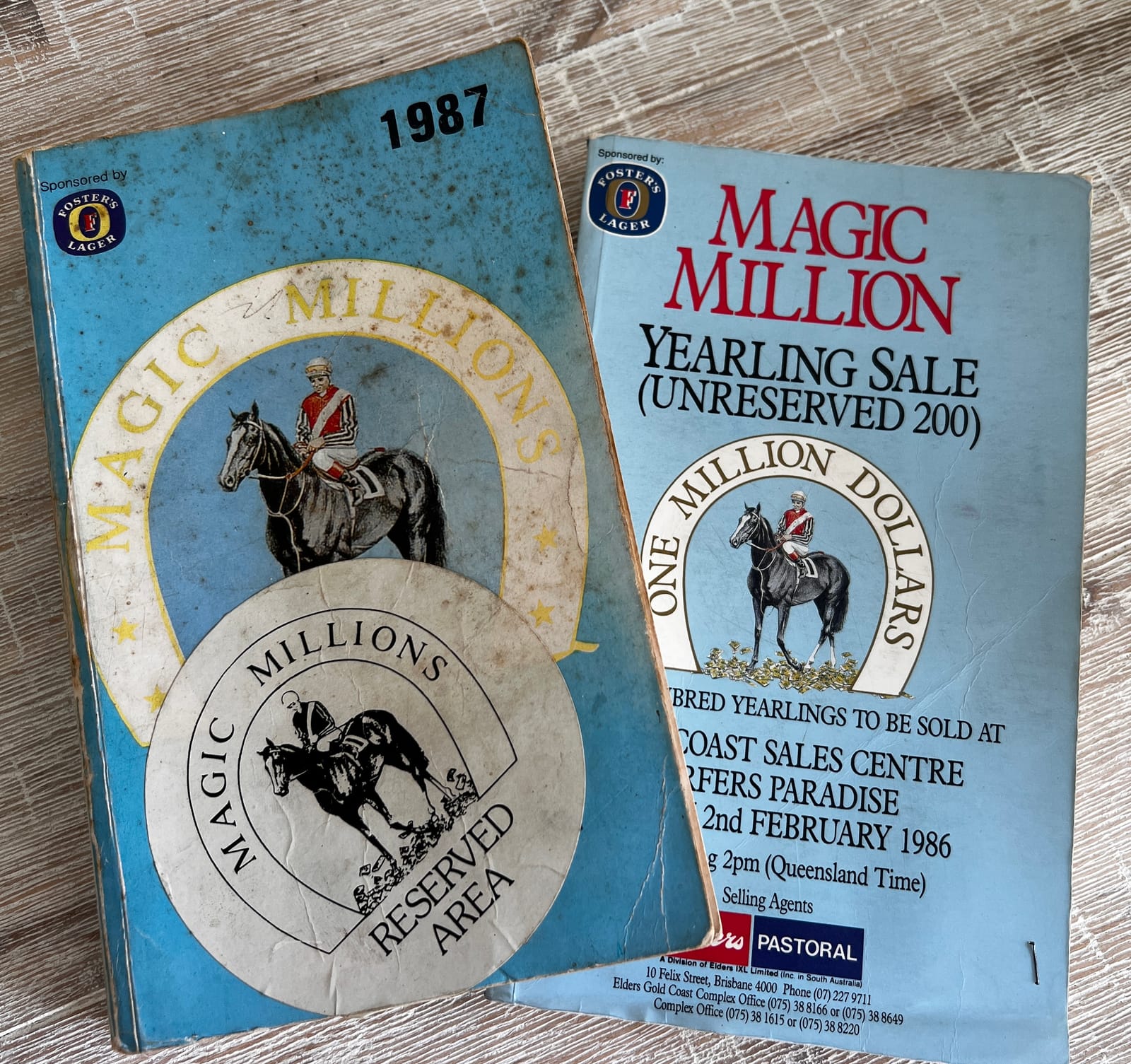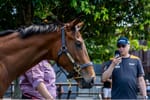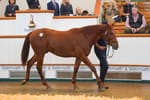They were ‘mad Queenslanders’, it was said in 1985 when the first Magic Millions race was announced. A juvenile sprint worth a million dollars open only to Gold Coast sale graduates.
It would never work.
Except that it did work and today, nearly 40 years later, the Magic Millions 2YO Classic is one of the sharpest, richest juvenile contests on the calendar. It has been copied the length of Australasia and around the world, and it’s largely unchanged since 1986.
The idea was a race restricted to horses purchased at the specially convened Magic Million Sale that year.
The catalogue featured just 200 horses, which were scouted from Queensland and NSW, and from such farms as Newhaven Park, Trans Media Park Stud (now Twin Hills), Milburn Creek and Middlebrook Park Stud.
They were youngsters by Rancher, Sir Tristram, Luskin Star and Bletchingly, and from a sale prediction of $3 million, the inaugural Magic Million grossed double that at more than $6.35 million, with 10,000 patrons crowding the six-year-old complex, including Bart Cummings, John Messara and Mike Willesee.
It took just 65 minutes and 30 lots for the sale to aggregate its first million dollars; it was a roof-raising success.
Nevertheless, the sale was just the first leg of the impossible.
After it wrapped up on February 2, 1986, its graduates had to prove their worth. After all, Queensland yearling averages at that time were around $5000, and the Magic Million yearlings had averaged more than $31,000.
They began hitting racetracks before Christmas, and by the running of the inaugural Magic Millions race on January 10, 1987, there was at least one rising star. He was called Snippets, a speedster by Lunchtime from the Grand Chaudiere mare Easy Date.
Snippets clattered away with the first Magic Million and then headed to Sydney where he won the Group 1 AJC Sires’ Produce Stakes. The following season, he won the Oakleigh Plate and The Galaxy, both Group 1s, and he later proved one of the formative stallions of his generation, siring Hasna, Pins and Casual Pass.
Snippets was the making of the Magic Millions concept. Without him, no one knows if it would have stood up, but history has largely forgotten that he wasn’t the only star to emerge from that pioneering first sale in 1986.
By October 1987, some months after Snippets’s win, 50 of the 200-horse catalogue had won races, and four of the inaugural race field also lined up in Marauding’s 1987 Golden Slipper. That number represented a quarter of the field.
The catalogue produced the stakes winners Mother Duck, who won the 1986 Gimcrack Stakes and The Shorts, as well as the Group 3 winner Alshandegha, a daughter of Vain, and the dual Group 3 winner Boasting.
History has also largely forgotten that the sale topper at the inaugural event in 1986, a colt bought by four Gold Coast nightclub owners and sent to Bart Cummings, won the 1987 Peter Pan Stakes, a race that is today the Golden Rose. He was called Roman General and he topped the sale at $210,000, bettering the previous Queensland yearling record of $80,000 set by a Sir Tristram youngster in 1983.
Snippets won the inaugural Magic Millions race.
Today, it is often written that there was much to improve about the Magic Millions concept. However, that is arguable given the barnstorming success of the first catalogue.
The concept was the brainchild of Queensland breeder and cattleman Carl Waugh, and bankrolled by Lyndhurst Stud’s Merrell ‘Mick’ Kruger and Gordon MacNicol of Gainsborough Lodge, these three the only men of about 10 initial investors that kept the faith in a Gold Coast-based sales centre.
The restricted-sale concept into a closed race had been done in France quietly, but it was Waugh’s execution of the 1986 sale and 1987 race that stamped its future. By 1988, Goffs Ireland had mimicked it, and all it needed was for the results to keep popping out of the Gold Coast.
By 1987, ‘The Magic Million’ was the ‘Magic Millions’. The sale catalogue that year was expanded to 400 horses, with a million-dollar race for colts and geldings in 1988, and another of equal value for the fillies.
Queensland’s racing minister Russ Hinze, the ‘minister for everything’, didn’t mince his words in his support of what Carl Waugh and his mates were delivering.
“I am justifiably proud of this magnificent concept held in my state,” he said. “We have seen the tenacity of a small group of Queenslanders as they spared no expense to make the Magic Millions a success. We can now see, with confidence, that this idea is here to stay.”
It was.
The Magic Millions two-year-old race churned out brilliant winner after brilliant winner, horses of the calibre of Bold Promise in 1991 and St Jude the year before, both of whom proved multiple Group winners and notable stallions during their lives.
In 1997, General Nediym won the race, followed by Testa Rossa, Assertive Lad and Regimental Gal in the early 2000s, until a succession of good names stepped up. Dance Hero in 2004 became the Classic’s first winner to also win the Golden Slipper, repeated by Phelan Ready and Capitalist in later years.
It’s fair to argue that right from its inception, the Magic Millions race exercised considerable influence over not only the Golden Slipper, but also the wider juvenile scene in Australia.
Today, with a catalogue pushing 1600 horses, the odds of getting a berth into the 2YO Classic are much worse. In 1986, in a catalogue of 200 horses, breeders paid a $10,000 entry fee per yearling and that horse, in turn, had a 1 in 200 chance of making the final field for their shot at a $500,000 first prize (plus trophies).
However, in reality those odds were much slimmer, and it was part of the advertising of the first sale. The odds today are much wider of a colt, gelding or filly making the cut from catalogues so large. As such, the incentives today are different.

In 1986, there was commentary that the sale’s prices were inflated as buyers scrambled for a shot at a million dollars. In 2024, that amount of money is nothing new in a landscape that includes the $20 million The Everest.
Instead, the Magic Millions concept is built around a season-long series of races, and they don’t stop at two years of age. The Magic Millions Guineas is for the three-year-olds, while the QTIS Open and Magic Millions Cup are all available for the older horses on the company’s banner $14 million raceday.
In other words, there are years-long incentives to buy from Magic Millions when, initially in 1986, there was just one.
This year’s 2YO Classic field has drawn the same silks that have frequented the winner’s circle in recent times. There is the Ozzie Kheir-led Spywire, the James Harron-owned Highness and the Godolphin colt Parkour, among others.
This race, without argument, has seen some of the great stallions through its ranks, and it remains a high priority for the colts’ syndicates. Equally, fillies like Coolangatta, Sunlight and Karuta Queen, all multiple stakes winners who knocked on the door of greatness, came through the Classic as winners.
‘There is little chance of a champion emerging from such limited numbers,’ one newspaper stated in 1986, but it needn’t have worried. The Magic Millions sale and race concept had started as it meant to go on, and all because of a few ‘mad Queenslanders’.




